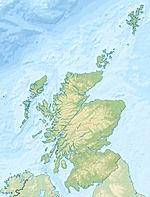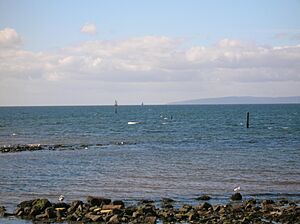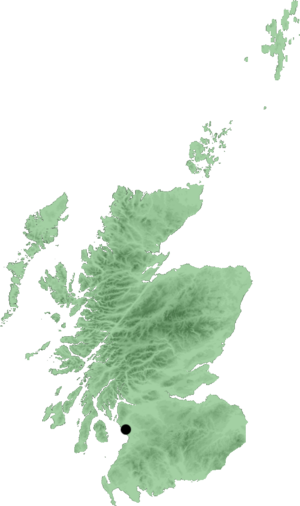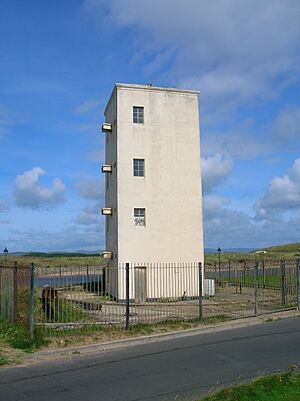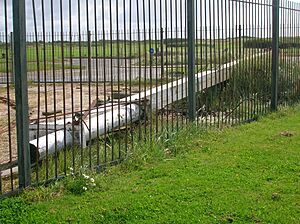Boyd's Automatic tide signalling apparatus facts for kids
Quick facts for kids Boyd's Automatic Tide Signalling Apparatus |
|
|---|---|
| Irvine, North Ayrshire, Scotland UK |
|

The Boyd Automatic Tide Signalling Apparatus
|
|
| Coordinates | 55°36′21″N 4°41′39″W / 55.605778°N 4.694139°W |
| Height | 50 foot tower, mast above |
| Site information | |
| Owner | North Ayrshire Council |
| Controlled by | Port of Irvine |
| Open to the public |
No |
| Condition | Mast removed |
| Site history | |
| Built | 1906 |
| Built by | Martin Boyd |
| In use | Until the 1970s |
| Materials | Harled brick |
The Automatic Tide Signalling Apparatus, also known as the Pilot House, is a special building at Irvine harbour in North Ayrshire, Scotland. It's a unique structure, meaning there's probably nothing else quite like it!
This amazing machine was invented and patented by Martin Boyd, who was the harbourmaster (the person in charge of the harbour) at Irvine. He came up with the idea in 1905, and the apparatus started working in 1906. Today, it's recognized as a historic building.
Contents
Irvine Harbour: A Busy Port
The Port of Irvine is located on the Clyde Coast, right next to the River Irvine. This port has been important for a very long time, with records showing it was active as early as the 1500s.
Challenges for Ships
Irvine Harbour is a tidal port, which means the water level changes with the tides. Also, two rivers, the Garnock and the Irvine, meet near the harbour's entrance. This caused a big problem: a sandbar often formed at the mouth of the harbour.
This sandbar made it hard for ships to get in and out. Sometimes, ships were stuck for months! To help, the harbour authorities started using a dredger (a machine that scoops up sand) in the 1750s. They also built stone walls that helped the river clean itself.
Even with these efforts, ship captains still didn't know how deep the water was over the sandbar. In 1847, there was a signal post where balls were raised to show the tide's depth. Tugs and other ships also helped by telling waiting vessels about the water levels.
Facing Competition
In the early 1900s, Irvine Harbour was losing business to other nearby ports like Troon and Ardrossan. These ports were owned by railway companies, which gave them an advantage. This competition made it even more important for Irvine to improve its harbour.
Martin Boyd: The Inventor
Martin Boyd, the Irvine Harbourmaster, wanted to find a better way to help ships. He lived at 56 Harbour Street and spent time figuring out how to improve access to the port.
On May 7, 1903, Martin Boyd designed and patented his "Automatic Tide Marker Station." His patent application explained that this machine would "automatically signal the depth of water at harbours." A postcard from 1906 even shows him standing proudly in front of his new tower!
How the Tide Marker Worked
The Automatic Tide Signalling Apparatus used clever technology for its time. It worked by sensing the rise and fall of the tide.
In the 1830s, there was a manual system where a person named Tom Tennant would hoist balls to show the water depth. Boyd's invention was a huge step forward because it was automatic!
A Clever System
The system had a floating chamber, like a wooden raft, located a little distance from the main building. This raft would float up and down with the tide. A cable connected the raft to the building, which locals called the 'Pilot House'.
Inside the Pilot House, the cable was attached to special metal frames called "eclipsers." As the tide rose, the eclipsers would move up. At night, these eclipsers would cover lights, turning them off one by one. This showed how deep the water was: more lights meant deeper water. A small bypass light always stayed on so the main lights could easily come back on when the tide went out.
During the day, the system used black balls. These balls were attached to ropes connected to the eclipsers. As the eclipsers rose, the ropes would pull the balls down, making them disappear inside the building. The number of balls visible showed the water depth. For example, twelve balls meant 18 feet of water.
There was also another signal system nearby. If two red lights (at night) or two black balls (during the day) were displayed, it meant ships should not enter or leave the harbour.
The Pilot House Building
The tower, which is 50 feet tall, was finished in 1906. Its white walls made it easy to see from the sea. Even today, it helps small boats find their way.
The building looks like a four-story tower, but it only has one floor above the ground. The upper part is mostly empty space, holding the signal equipment. The original signal balls were made of canvas over a metal frame. Small landings and ladders inside allowed access to the lights and other parts of the system. The ground floor was used by the harbour pilots as their meeting room, which is why the building became known as 'The Pilot House'.
- Views of the 'Pilot house' - 2007
Grand Opening Day
On May 23, 1906, the Automatic Tide Signalling Apparatus was officially opened. Important people like the Provost of Irvine and members of the Irvine Harbour Trust attended. After speeches, the group took a trip on a steam tug to Largs. They returned later that night to check the lights and were "completely satisfied" with the new system.
A newspaper advertisement at the time announced the new system to sailors: "Notice to Mariners - The Irvine Harbour Trustees hereby give notice that they have erected Boyd's patent AUTOMATIC TIDE SIGNALLING APPARATUS, which will be opened on Wednesday 23rd curt., and will from that day exhibit from a tower a code of ball signals. The tower is situated 40 yards or thereby southwards of the present green light."
- Views of Irvine harbour - 2007
-
The River Irvine with the town in the background.
-
The River Garnock with the old ICI Explosives' jetty to the left.
-
Looking seaward towards the Scottish Maritime Museum's pontoons.
-
The Scottish Maritime Museum with the old ICI Explosives tug MV Garnock to the right.
The Pilot House Today
The Automatic Tide Marker Station worked well, but Irvine Harbour's trade still declined. This was partly because it was a tidal harbour and faced strong competition. By the early 1990s, the last cargo (explosives from a nearby plant) stopped being handled at the harbour.
The System Falls Silent
The Pilot House was updated with electric lights, but the system eventually stopped being used in the early 1970s. Over time, the building started to fall apart. Rain got in, causing wood to rot, and cracks appeared. The floating chamber became filled with silt, and the connecting cables disappeared.
The building is a protected historic structure. In 1989, repairs were made. The Scottish Maritime Museum and others have tried to fully restore this unique building and its system. For a while, the Irvine Model Boat Club used the building, and a model railway club even laid tracks nearby. Today, most of the mast is gone, and the building looks neglected.
Restoring the Pilot House
In 2013, a group called Coastwatch Scotland started a project to turn the Pilot House into a watch tower. This would benefit both local people and visitors. By November 2016, the first part of the restoration was complete. A new roof, windows, and door were installed, the building was repainted, and a radio aerial was added.
Interesting Facts
- During World War II, a Royal Observer Corps watchtower was located here. This was because the building offered a great view of the Firth of Clyde.
- It's believed that the Pilot House was the first place to spot Rudolf Hess's plane in 1941.
- In 2014, a model builder named James Miller created a model of the Pilot House using old photos. He gave it to the Scottish Maritime Museum to help them tell the story of this special building.


